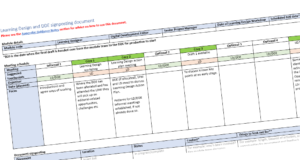By Amy Leon and Catherine Du Baret
High quality, online and distance education materials, building on a huge legacy of groundbreaking distance education. This is what Learning Designers and editors, working alongside academic colleagues, at the Open University shape and hone during the creation of new modules.
The Open University (OU) creates around 150 new modules each year, to sit alongside over 350 represented modules offered to students. The Learning Designer and Digital Development Editor roles are pivotal to the development and production of new modules and are involved right from the start, working alongside authors and faculty colleagues, to support and advise on plans. Other specialists, such as video and audio producers, interactive developers and graphic developers, are brought in at various points in the development, as and when they are needed. If you’re not familiar with Learner and Discovery Services (LDS) at the OU, LDS teams work closely with colleagues across the University to design, produce and deliver online and printed learning materials for students. This is a collaborative arrangement which engages our dedicated Learning Design, Learning Innovation, Development and Production, and Commissioning teams.
Learning Designer role
For the Learning Designer (LD), establishing a good relationship with key stakeholders in the module is the first interaction. The Learning Designer will run a series of learning design workshops to help the team establish key parameters for the module, for example, what’s the context of the module, who will study it and what do those students need to get out of it?
They reflect with teams about the learning journey and support the author’s thinking about how they make design decisions. From these meetings the Learning Designer puts together the Learning Design Action Plan which sets out key design decisions for the module. Towards the end of the draft process the Learning Designer will map student workload to highlight issues with consistency.
Digital Development Editor role in early involvement
The Digital Development Editor (DDE) attends learning design and drafting meetings with the module team, adding input where possible and answering questions arising. At drafting stage, the Digital Development Editor reviews drafts against the ICEBERG principles (Van Ameijde, Weller and Cross, 2016) and feeds back to the module team. A key tool in this review process is the Drafting Cover Sheet which provides prompts for the Digital Development Editor to comment on the learning outcomes, assessments, workload, word count and Equity, Diversity and Inclusion (EDI). Introducing this coversheet was a key step in creating consistency across modules in production – this is particularly important due to the scale at which the Open University operates!
Learning Designer and Digital Development Editor touchpoints
It’s critical that the Learning Designer and Digital Development Editor work together at the early stages of a module. There are four core touchpoints:
- Learning Design workshop
- Learning Design Action Plan review meeting
- Drafting stage
- Handover to production, using the LD DDE signposting planning tool
In addition, informal meetings are strongly encouraged, initially to agree ways of working, and subsequently regular check-ins to ensure consistency of approach. A purpose made signposting tool establishes touchpoints between the two roles during the project, acts as a summary of the discussion, and centralises links to other mutually important documents such as the Learning Design Plan.

As the module moves from drafting stage to production, content starts to be handed to the editorial production teams and the Learning Designer takes a step back, allowing the editorial team to prepare the content for delivery to students. However, the learning designer remains on-hand to collaborate with Digital Development Editors where that’s beneficial throughout production process. We recently spoke to the Digital Development Editor and Learning Designer for a recent STEM module about their experience with the process.
Case study: Designing for a STEM module
The Digital Development Editor, Learning Designer and Senior Project Manager (SPM) kicked off the work on this module by meeting up, with the aim of setting out a plan for how to support the module team in the design phase of module production. Because of the Digital Development Editor’s experience on a sister module, there was concern about student workload and so this was chosen as the focus of the work.
Both Learning Design Workshops run by the Learning Designer were attended by the Digital Development Editor and it was there that they were able to start building relationships and trust with the team and introduce the themes of structure and workload. They discussed their ideas and perspectives with the Senior Project Manager, and this helped to foster clear lines of communication and team culture.
The Learning Designer and Digital Development Editor built an excellent working relationship which paid dividends later in the process. The Learning Designer was able to talk through any issues with the Digital Development Editor knowing that they would understand. The Digital Development Editor was able to offer support and encouragement and worked with the Learning Designer to identify blockers and move the design on. They chose to present solutions that put the students first.
They encouraged the module team to build on their previous experience and develop a curated learning journey. They presented a menu to the module team to give them easy choices about the design. Module teams are often very busy with other aspects of production and so the Learning Designer and Digital Development Editor joined forces and were very clear about what was most important for students. They emphasised clear communication, especially around assessment, and consistency. Through the work with the Learning Designer and Digital Development Editor, the module team decided to adopt mind maps consistently through the content.
When it came to the module production phase, the Learning Designer and Digital Development Editor used the signposting tool to document their work. This was very helpful in confirming a shared understanding as well as having something to refer back to later in the process.
This teamworking was so successful that the Learning Designer is now trying to replicate this good practice in other modules with other colleagues.
Top tips for Digital Development Editors and Learning Designers
- Work at establishing a good relationship between the Learning Designer and Digital Development Editor, work as a team and trust each other.
- Support each other and back each other up.
- Communicate outside of module team interactions.
- Use the tools available.
- Arrange the work in interweaving stages rather than in parallel as this helps to reduce load on the module team.
References
Van Ameijde, J., Weller, M. and Cross, S. (2016) ‘Designing for Student Retention The ICEBERG model and key design tips’, Institute of Education Technology (IET), The Open University. (Accessed 1 February 2022).
Acknowledgements
Thank you to Paul Hoffman and Paul Astles for their contribution.

